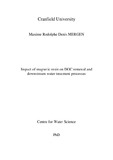JavaScript is disabled for your browser. Some features of this site may not work without it.
| dc.contributor.advisor | Parsons, Simon | |
| dc.contributor.advisor | Jarvis, Peter | |
| dc.contributor.advisor | Jefferson, Bruce | |
| dc.contributor.author | Mergen, Maxime Rodolphe Denis | |
| dc.date.accessioned | 2008-07-08T18:30:13Z | |
| dc.date.available | 2008-07-08T18:30:13Z | |
| dc.date.issued | 2008-01 | |
| dc.identifier.uri | http://hdl.handle.net/1826/2702 | |
| dc.description.abstract | Seasonal periods of high rainfall and changes in land management have led to difficulties for UK water companies to remove sufficient natural organic matter (NOM) to stay in compliance with the tightening trihalomethane (THMs) standards. Hence alternative treatment options have come into focus of research and development. The continuous anion exchange process based on a novel magnetic resin (MIEX® resin) has emerged as a promising method to increase NOM removal and has been compared in this thesis to the most widely spread drinking water treatment method of coagulation with hydrolysing metal salts. Therefore the removal efficiency of both processes was investigated by treating different natural waters sources as well as selected organic model compounds of different hydrophobicity and molecular weight (MW). Magnetic resin was thereby seen to be competitive with coagulation for DOC removal in low SUVA sources dominated by mid to low MW material and to outperform coagulation for the treatment of low MW, hydrophilic acids. However magnetic resin had to be used in combination with subsequent coagulation using largely reduced Fe doses to ensure high levels of DOC removal in sources dominated by high MW NOM. This was related to a physical blockage mechanism of the easily accessible external resin bead surface by this high MW material. An effect that could be reduced by applying increased resin doses, which provided a larger external surface area for DOC removal. A combination of magnetic resin treatment with coagulation was nonetheless seen to be able to increase DOC removal as well as to generate enhanced floc properties in terms of strength, settling velocity and size. Beside a reduced THM formation potential, making magnetic resin an effective tool to help meet legislative standards, an increased solid-liquid separation was seen in pilot-scale to result from these effects. | en_UK |
| dc.language.iso | en | en_UK |
| dc.publisher | Cranfield University | en_UK |
| dc.rights | © Cranfield University 2008. All rights reserved. No part of this publication may be reproduced without written permission of the copyright owner. | en_UK |
| dc.title | Impact of magnetic resin on DOC removal and downstream water treatment processes | en_UK |
| dc.type | Thesis or dissertation | en_UK |
| dc.type.qualificationlevel | Doctoral | en_UK |
| dc.type.qualificationname | PhD | en_UK |
